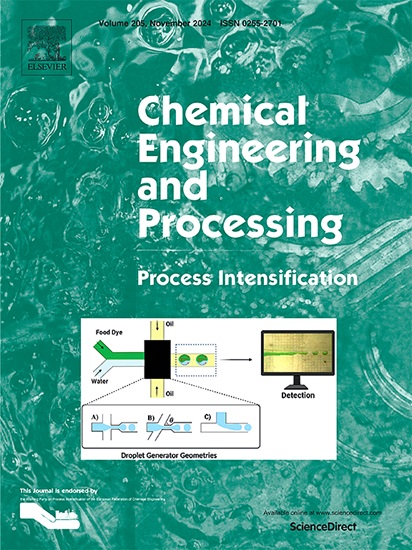CFD analysis of the intensification mechanism of bubble breakup by perforated plates in a bubble column
IF 3.8
3区 工程技术
Q3 ENERGY & FUELS
Chemical Engineering and Processing - Process Intensification
Pub Date : 2025-03-28
DOI:10.1016/j.cep.2025.110288
引用次数: 0
Abstract
Conventional bubble column reactors suffer from some drawbacks like severe backmixing and poor heat/mass transfer performance. The process intensification by the utilization of perforated plates has been an important strategy to overcome these problems. However, a fundamental understanding of the bubble breakup by perforated plates is still very limited. CFD simulations are carried out to reveal the interaction between the rising bubbles and perforated plates. It is found that no bubbles break up when they just pass through the hole. A bubble can be broken into three small daughter bubbles when it collides with the bridge connecting three holes. The bubble breakup is mainly attributed to the bridge cutting, whereas it is not sensitive to large hole diameters. A large bubble cap is formed underneath the plate due to very small hole diameter. The plate thickness has no significant influence on bubble breakup. When the inclined angle of a perforated plate is larger than 45°, the bubbles slide beneath the plate more readily and no bubbles pass through it. The perforated plate with large inclined angle fails to induce bubble breakup. This study would provide deep insights into bubble breakup mechanism related to process intensification by perforated plates.

气泡柱中穿孔板破碎气泡强化机理的CFD分析
传统的气泡塔反应器存在返混严重、传热传质性能差等缺点。利用多孔板强化工艺是克服这些问题的重要策略。然而,对穿孔板破泡的基本理解仍然非常有限。通过CFD模拟揭示了上升气泡与穿孔板之间的相互作用。结果表明,气泡在刚通过孔时不会破裂。当一个气泡与连接三个孔的桥相碰撞时,它可以分成三个小的子气泡。气泡破碎主要是由桥切引起的,而对大孔径不敏感。由于孔直径很小,在板下形成一个大的气泡帽。板厚对气泡破碎无显著影响。当穿孔板的倾斜角大于45°时,气泡更容易在板下滑动,没有气泡通过。大倾角的穿孔板不能诱导气泡破碎。该研究将对穿孔板过程强化的破泡机理提供深入的认识。
本文章由计算机程序翻译,如有差异,请以英文原文为准。
求助全文
约1分钟内获得全文
求助全文
来源期刊
CiteScore
7.80
自引率
9.30%
发文量
408
审稿时长
49 days
期刊介绍:
Chemical Engineering and Processing: Process Intensification is intended for practicing researchers in industry and academia, working in the field of Process Engineering and related to the subject of Process Intensification.Articles published in the Journal demonstrate how novel discoveries, developments and theories in the field of Process Engineering and in particular Process Intensification may be used for analysis and design of innovative equipment and processing methods with substantially improved sustainability, efficiency and environmental performance.

 求助内容:
求助内容: 应助结果提醒方式:
应助结果提醒方式:


